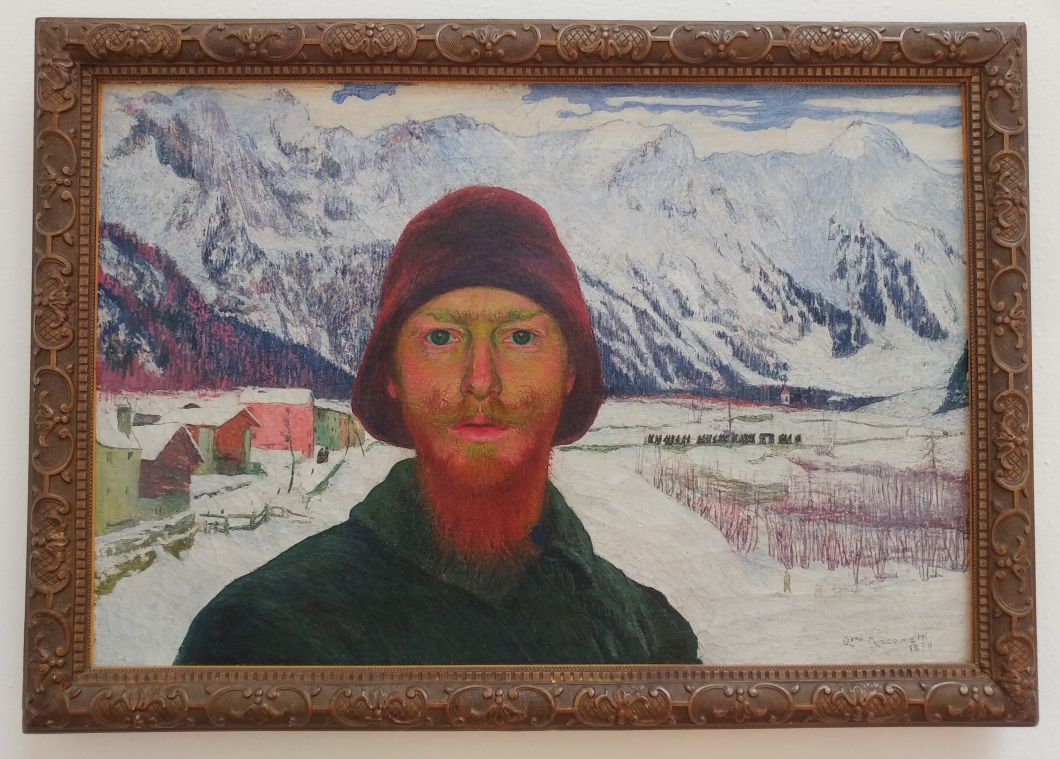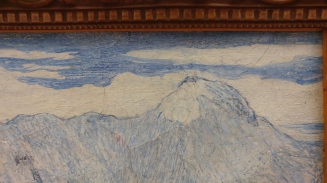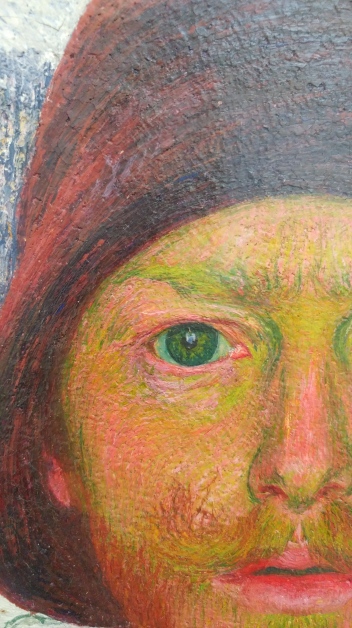
In my latest ‘First Impressions’ post, I paid a visit to the Musée d’Art et d’Histoire, Geneva. The First Impressions pieces are intended to be a faithful record of my thoughts on being confronted with an artwork. They are written in situ in front of the piece, and without further research. The longer you sit with an artwork the more you get out of them, and these pieces are in a sense exercises in ‘slow looking’, as well as close looking. I would highly encourage you to pick a painting that appeals to you, and sit with it for an hour or so, and discover what you see. Comment below if you do this too!
Situated in one of the smaller rooms on the second floor of the museum, this painting immediately caught my eye. It has such an audacious composition. He stares out at you in a way few paintings achieve, it is a truly piercing gaze. He has chosen to situated himself within a bright winter landscape, the kind with fast moving clouds and a little warmth from the sun balancing the cold gusts of wing. The composition is essentially that of a bust, almost superimposed over a landscape painting. This gives the work a great sense of immediacy, and intimacy. One can’t help but feel that the interaction which brought us so close to him, and with him bearing such an expression, would be a somewhat socially awkward one, but it gives the work an almost photographic sense of modernity. This is a type more familiar to us from photojournalism than from paintings of late Nineteenth century Switzerland.
It’s hard not to compare self-portraits of red-heads with that other, most famous of ginger artists, and it is possible that Giacometti was familiar with the work of Van Gogh. He certainly does seem to be familiar with new approaches to colour and brushwork that were being explored in Paris at the time. Geneva was becoming more artistically significant during this period, with a burgeoning art scene, due in part to its close links with Paris. For the majority of the painting, Giacometti’s choices of colour are fairly naturalistic. It is in his brushwork that he is more daring, with dense networks of directional brushstrokes giving and undisciplined but effective impression of the craggy, jagged, and snow-covered mountains. Whereas earlier artists would tend towards hiding their brushwork, smoothing brushstrokes away to focus on careful variations creating depth and volume (such as in the earlier works of leading Swiss artist Hodler), Giacometti chooses varied and visible brushstrokes, which are more evocative of being in  the landscape. Nothing about the painting is idealised; this is a rough, challenging landscape which tests those who have to live within it. He uses a fairly typical post-Impressionist method in outlining the top of the mountain in long, continuous, and dark brushstrokes. This adds to the feeling that one is being situated within the landscape; it mimics the silhouette effect achieved by the bright sun. It is in its way a carefully studied landscape, with the scars of avalanches and snowdrifts creeping their way down through the pines.
the landscape. Nothing about the painting is idealised; this is a rough, challenging landscape which tests those who have to live within it. He uses a fairly typical post-Impressionist method in outlining the top of the mountain in long, continuous, and dark brushstrokes. This adds to the feeling that one is being situated within the landscape; it mimics the silhouette effect achieved by the bright sun. It is in its way a carefully studied landscape, with the scars of avalanches and snowdrifts creeping their way down through the pines.

While it is in some ways thus a highly ‘naturalistic’ work, creating an evocative impression of an experience of place, it would be unfortunate to miss the ways in which the artist has asserted himself within the landscape. Obviously, he has done this quite blatantly in his choice of pose and composition, but we also see this in his choice of colours. Various shades of green and pink dominate the lower half of the painting, seen in the trees and houses, for instance, and most prominently in the artist’s own face. Here we see the modernity of his brushwork united with a modern approach to colour. The use of contrasting green and pink, in very fine brushstrokes, works to bring a vividness to the face, befitting such a frank and confrontational pose.

I’m not generally one for trying to read too much into the expressions of painted individuals. This is an area which is too much about reception, and where it is perhaps best to consider the death of artist and the birth of reader(/viewer). However it is tempting to consider Giacometti’s look as one of almost revelation, it speaks of a sudden awareness of one’s place in the world, not in relation to any social standing, but rather a more Romantic awareness of place within the wider world. Nothing in a painting is incidental, and from his face we are clearly drawn to the funeral procession behind him, moving inexorably towards the church nested down the valley amongst the trees. Whether we read this as a reflection of his personal realisation is largely a matter of taste. The inclusion can be seen to fit with the effect of the painting capturing the essence of life (and therefore death) in the landscape it depicts. Despite compositionally being placed in front/on top of the landscape, he has positioned himself as part of it. His dense felt hat comes low over his ears, keeping out Alpine gusts, and his thick woollen coat is buttoned all the way up. Though he turns to face us, his shoulders are at an angle, and he steps out into the landscape. The two black figures, stragglers from the funeral, create a sense of movement across the canvas; perhaps he will join them? The painting fills one with a sense of bearing witness, and becoming part of a way of life, lived from start to finish, in tough conditions. Thus, Giacometti has not just offered us an image of a place, or an idea of a place, but rather a complete, involved, and honest experience of what it is to exist in that place. His questioning gaze invites us in, and we are led to contemplate this existence alongside him. Thus a painting which could come across as egotistical, putting himself, the individual, front and centre in the most literal of senses, gains a degree of universality; rather than being a focus in its own right, the individual (artist/us) becomes part of a greater, human story.
You can read some of my thoughts on the genre of self-portraiture here.